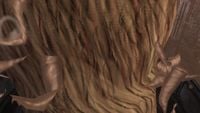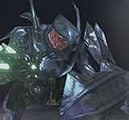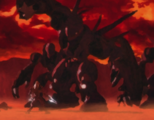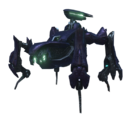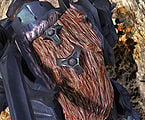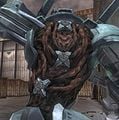Lekgolo: Difference between revisions
From Halopedia, the Halo wiki
Sith Venator (talk | contribs) (Quite interesting. This Canon Fodder makes up for the two crappy waypoint articles.) |
No edit summary |
||
| Line 29: | Line 29: | ||
==History== | ==History== | ||
The Lekgolo evolved on their homeworld of [[Te]], and thrived by feeding off the rich metal deposits in the planet's crust. The [[Forerunner]]s cataloged the Lekgolo in their time, albeit in considerably different assemblages than the ones that would be encountered later on.<ref name="bestiarum">'''[[Bestiarum]]'''</ref> A number of | The Lekgolo evolved on their homeworld of [[Te]], and thrived by feeding off the rich metal deposits in the planet's crust. The [[Forerunner]]s cataloged the Lekgolo in their time, albeit in considerably different assemblages than the ones that would be encountered later on.<ref name="bestiarum">'''[[Bestiarum]]'''</ref> Lekgolo specimens of the [[Thanolekgolo]] configuration were to be used in a failed plan undertaken by the Forerunners to defeat the [[Flood]].<ref name="Have S'moa">[https://www.halowaypoint.com/en-us/community/blog-posts/canon-fodder-have-s-moa '''Halo Waypoint''': ''Canon Fodder: 2-20-15'']</ref> A number of these specimens were ultimately buried under the surface of [[Installation 04]] by the Forerunners for unknown reasons.<ref name="recon">'''[[Halo: Nightfall: RECON-14]]'''</ref> | ||
Since their combined forms could potentially be highly intelligent, the Lekgolo species were able to develop [[Technological Achievement Tiers|Tier 3]] technology on their own, though their space travel capabilities remained highly limited due to the high gravity of their homeworld.<ref name="bestiarum"/> At some point in their history, a number of Lekgolo colonies settled in Forerunner installations orbiting Te. These colonies developed distinct appetites; while many consumed the Forerunner structures themselves for food, others ate anything except Forerunner materials. After several millennia, the Forerunner constructs were almost completely broken down, with the debris forming rings in the planet's orbit.<ref name="ch">'''Halo: Contact Harvest''', ''pages 269-271''</ref> | Since their combined forms could potentially be highly intelligent, the Lekgolo species were able to develop [[Technological Achievement Tiers|Tier 3]] technology on their own, though their space travel capabilities remained highly limited due to the high gravity of their homeworld.<ref name="bestiarum"/> At some point in their history, a number of Lekgolo colonies settled in Forerunner installations orbiting Te. These colonies developed distinct appetites; while many consumed the Forerunner structures themselves for food, others ate anything except Forerunner materials. After several millennia, the Forerunner constructs were almost completely broken down, with the debris forming rings in the planet's orbit.<ref name="ch">'''Halo: Contact Harvest''', ''pages 269-271''</ref> | ||
| Line 44: | Line 44: | ||
During the [[Great Schism]], the species was divided between those that remained loyal to the Covenant, led by the [[Prophet of Truth]], and those that supported the [[Swords of Sanghelios|Covenant separatists]]. During the [[Post-Covenant War conflicts|further human-Covenant conflicts]] in the wake of the [[Human-Covenant War]] many would fight on behalf of [[Jul 'Mdama]]'s [[Jul 'Mdama's Covenant faction|new Covenant order]] against humanity.<ref>'''Halo 4'''</ref> | During the [[Great Schism]], the species was divided between those that remained loyal to the Covenant, led by the [[Prophet of Truth]], and those that supported the [[Swords of Sanghelios|Covenant separatists]]. During the [[Post-Covenant War conflicts|further human-Covenant conflicts]] in the wake of the [[Human-Covenant War]] many would fight on behalf of [[Jul 'Mdama]]'s [[Jul 'Mdama's Covenant faction|new Covenant order]] against humanity.<ref>'''Halo 4'''</ref> | ||
After the destruction of [[Installation 04]], feral | After the destruction of [[Installation 04]], feral Thanolekgolo swarms that had been sealed beneath the ring's surface by the Forerunners were able to break free in certain sections of the ring, namely [[Alpha Shard]], a fragment propelled through slipspace into a close orbit around a red giant. Because of their extremophilic nature and ability to burrow underground, the Lekgolo were able to survive on the fragment for years despite the extreme daytime temperatures.<ref name="recon"/> These Lekgolo were highly aggressive, and significantly faster and more agile than their more commonly-encountered brethren.<ref name="hnf2">'''Halo: Nightfall''', ''Chapter 2''</ref> During a joint [[ONI]]-[[Sedran Colonial Guard]] [[Mission to Alpha Shard|expedition to Alpha Shard]], these Lekgolo swarms hunted and consumed almost the entire group, leaving only two survivors.<ref name="hnf2">'''Halo: Nightfall''', ''Chapter 2''</ref> | ||
==Description== | ==Description== | ||
| Line 54: | Line 54: | ||
Lekgolo are relatively unintelligent at the most basic level, but can form complex thoughts and emerge as a conscious individual when they combine into larger masses that communicate through chemical and electrical means. A colony's level of intelligence is generally dependent on the amount of neural mass present,<ref name="waypointarticle"/> and can be scaled upward to a certain extent for increased intelligence. The neural net that a Lekgolo colony develop enables them to be incredibly strong and very sensitive to their surroundings.<ref name="bestiarum"/> | Lekgolo are relatively unintelligent at the most basic level, but can form complex thoughts and emerge as a conscious individual when they combine into larger masses that communicate through chemical and electrical means. A colony's level of intelligence is generally dependent on the amount of neural mass present,<ref name="waypointarticle"/> and can be scaled upward to a certain extent for increased intelligence. The neural net that a Lekgolo colony develop enables them to be incredibly strong and very sensitive to their surroundings.<ref name="bestiarum"/> | ||
Because of their make-up of several hundred worms instead of being a single large organism, the Lekgolo are one of the only species in the Covenant that cannot be assimilated by the [[Flood]], as their unique physiology does not allow the organism to access a central nervous system or control them to any capacity. As such, there has never been a Mgalekgolo [[Flood combat form]], though the flesh of the Lekgolo can most likely be used by the Flood simply for its biomass.<ref>'''Halo: Evolutions - Essential Tales of the Halo Universe''', ''Wages of Sin'': ''page 301''</ref> | Because of their make-up of several hundred worms instead of being a single large organism, the Lekgolo are one of the only species in the Covenant that cannot be assimilated by the [[Flood]], as their unique physiology does not allow the organism to access a central nervous system or control them to any capacity. As such, there has never been a Mgalekgolo [[Flood combat form]], though the flesh of the Lekgolo can most likely be used by the Flood simply for its biomass.<ref>'''Halo: Evolutions - Essential Tales of the Halo Universe''', ''Wages of Sin'': ''page 301''</ref> | ||
Revision as of 12:21, February 22, 2015
"WE'VE GOT A NEW CONTACT, UNKNOWN CLASSIFICATION!" This article may contain information based upon upcoming, unreleased, or recently-released content, and may not be fully complete. Additionally, the information may be subject to change if it is based on pre-release material. Please update it as soon as any relevant and accurate material is available.
|
The Lekgolo[1] (Latin Ophis congregatio, meaning "Assembly of snakes")[2] are a species of small colonial worm-like creatures that can join together to form purpose specific assemblages, such as Mgalekgolo, commonly referred to by humans as Hunters. Every worm-like creature is an individual eel, about 1.4 meters long, with its own central nervous system.
Lekgolo are also able to combine themselves within machinery such as the Type-47 Scarab and use their combined intelligence to pilot, or control, the vehicle or machinery.[3]
History
The Lekgolo evolved on their homeworld of Te, and thrived by feeding off the rich metal deposits in the planet's crust. The Forerunners cataloged the Lekgolo in their time, albeit in considerably different assemblages than the ones that would be encountered later on.[2] Lekgolo specimens of the Thanolekgolo configuration were to be used in a failed plan undertaken by the Forerunners to defeat the Flood.[4] A number of these specimens were ultimately buried under the surface of Installation 04 by the Forerunners for unknown reasons.[5]
Since their combined forms could potentially be highly intelligent, the Lekgolo species were able to develop Tier 3 technology on their own, though their space travel capabilities remained highly limited due to the high gravity of their homeworld.[2] At some point in their history, a number of Lekgolo colonies settled in Forerunner installations orbiting Te. These colonies developed distinct appetites; while many consumed the Forerunner structures themselves for food, others ate anything except Forerunner materials. After several millennia, the Forerunner constructs were almost completely broken down, with the debris forming rings in the planet's orbit.[6]
Contact with the Covenant
- Main article: Taming of the Lekgolo
The Lekgolo first came into contact with the Covenant when the alien order arrived in search of Forerunner artifacts in 789 BCE.[7] They discovered that the Rings of Te were the remains of Forerunner constructs, soon realizing the Lekgolo were responsible for destroying them. The San'Shyuum viewed this as heresy, and declared war on the Lekgolo in what would later be called the Taming of the Lekgolo.[6] Covenant fleet commanders soon found that indiscriminate destruction would have unacceptable consequences: since the Lekgolo lived in the sacred relics that the Elites were trying to preserve, simply annihilating the Lekgolo would have resulted in the destruction of those relics.[6]
Likewise, carrying out a ground campaign against the Lekgolo proved difficult, as the Lekgolo were able to combine into powerful collectives, most notably the Mgalekgolo;[7] consequently, the Lekgolo won most, if not all, ground engagements.[2] The Covenant's forces were completely overwhelmed by the sheer size, ferocity and teamwork of their foes.[6] As a result, the Arbiter that was created during this crisis suggested that they could be "tamed" and put to better uses as part of the Covenant. The San'Shyuum eventually agreed and decided to forge a pact with the Lekgolo, allowing them to join the Covenant despite their offenses against "sacred" Forerunner artifacts.[6][2]
Service in the Covenant
Despite initial difficulties at contact due to the Lekgolo's alien methods of communication,[2] the Covenant incorporated the Lekgolo into their ranks in 784 BCE.[8] The Mgalekgolo gestalts, armed with thick armor plates and assault cannons, would come to serve the Covenant as shock troops. Even larger Lekgolo colony assemblages were weaponized as Covenant assault platforms, Scarab and the Harvester, the latter of which is operated by a meta-colony referred to as a Sbaolekgolo.[9] Individual Lekgolo worms, specifically conditioned not to ingest Forerunner alloys, were employed by the ascetic priests studying the Forerunner Dreadnought in High Charity.[6] A number of these Lekgolo stopped Mendicant Bias from taking off in the Forerunner Dreadnought by short circuiting the ship's systems, themselves dying in the process.[10]
During the Great Schism, the species was divided between those that remained loyal to the Covenant, led by the Prophet of Truth, and those that supported the Covenant separatists. During the further human-Covenant conflicts in the wake of the Human-Covenant War many would fight on behalf of Jul 'Mdama's new Covenant order against humanity.[11]
After the destruction of Installation 04, feral Thanolekgolo swarms that had been sealed beneath the ring's surface by the Forerunners were able to break free in certain sections of the ring, namely Alpha Shard, a fragment propelled through slipspace into a close orbit around a red giant. Because of their extremophilic nature and ability to burrow underground, the Lekgolo were able to survive on the fragment for years despite the extreme daytime temperatures.[5] These Lekgolo were highly aggressive, and significantly faster and more agile than their more commonly-encountered brethren.[12] During a joint ONI-Sedran Colonial Guard expedition to Alpha Shard, these Lekgolo swarms hunted and consumed almost the entire group, leaving only two survivors.[12]
Description
Anatomy and physiology
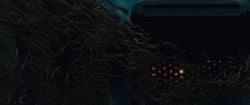
The Lekgolo are characterized by their ability to form bonds with one another both physically and neurologically to form gestalt colonies with a singular personality; these communities, rather than individual Lekgolo eels, are considered the closest thing to a Lekgolo "individual".[13] These gestalts are capable of manifesting in several different forms according to what goal they are striving to achieve and the amount of Lekgolo worms that are present. Their society is predominated by this combination of being able to create exponentially more intelligent creatures which fill various specific caste roles.[7] The Mgalekgolo, employed by the Covenant as heavy infantry, is the most common form seen in combat during the Human-Covenant War, but is actually one of the rarer and smaller forms in the Lekgolo society, used primarily in interaction with the Covenant hierarchy.[2] The Covenant were aware of six different forms of Lekgolo colony: Dipholekgolo, Mgalekgolo, Rhulolekgolo, Sbaolekgolo, Khantolekgolo, and Thanolekgolo. Each of these gestalts differs in size, mass and complexity and fills a specific niche in the Lekgolo's own society.[7]
The Lekgolo are xenobiologically classified as a "subsistence gestalt", defined as an alien gestalt community with the ability to survive in extreme conditions, such as the vacuum of space, for months or even years with barely any to no outside resources. The Lekgolo are the most extraordinary case of such organism encountered by humanity, as they were able to survive in Te's orbital rings for vast periods of time.[7] The Forerunners' Bestiarum noted that the Lekgolo are one of the most successful and culturally enigmatic gestalt intelligences in their home arm of the Milky Way galaxy.[2]
Lekgolo are relatively unintelligent at the most basic level, but can form complex thoughts and emerge as a conscious individual when they combine into larger masses that communicate through chemical and electrical means. A colony's level of intelligence is generally dependent on the amount of neural mass present,[7] and can be scaled upward to a certain extent for increased intelligence. The neural net that a Lekgolo colony develop enables them to be incredibly strong and very sensitive to their surroundings.[2]
Because of their make-up of several hundred worms instead of being a single large organism, the Lekgolo are one of the only species in the Covenant that cannot be assimilated by the Flood, as their unique physiology does not allow the organism to access a central nervous system or control them to any capacity. As such, there has never been a Mgalekgolo Flood combat form, though the flesh of the Lekgolo can most likely be used by the Flood simply for its biomass.[14]
Lekgolo blood is a luminescent orange and smells like burnt plastic.[15]
Culture
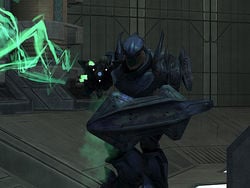
Little information exists on the internal workings of Lekgolo society, and their political and intellectual structures have been subject to many theories.[2] Most of the information on the Lekgolo is based solely on the Mgalekgolo, which provides only a small hint at the species in its entirety.[7] The Lekgolo almost never associate or even communicate with the other races in the Covenant. Sangheili are the sole exception; the Mgalekgolo appreciate and acknowledge the Sangheili warriors' thoughts and adeptness in combat. To the other races of the Covenant, however, the Mgalekgolo are dismissive, scornful, and arrogant, and they are utterly contemptuous of their foes.[16] Mgalekgolo have no qualms about committing friendly fire against the "lesser" races, like Unggoy and Kig-Yar; during the Battle of Sigma Octanus IV, a Hunter was seen running over and killing an unaware Kig-Yar.[17] In battle, Mgalekgolo will attack foes regardless of any allies that happen to be in their line of fire.[18]
Many members of the Covenant are mystified and confused by the Lekgolo; their way of life is almost as alien to the Covenant as that of the Flood. A Sangheili Fleet Master once noted that Mgalekgolo were known to tear opponents apart with their "bare hands" whilst in a blood frenzy, and then suddenly pause to recite war poetry. It has also been said that Mgalekgolo meditate in their spare time, or before battle.[19]
Role in the Covenant
The most commonly seen variety of Lekgolo are the Mgalekgolo, hulking bipedal forms used for service within the Covenant military.[2] In this form, they are the strongest and most resilient combatants in the Covenant.[20] Much larger bipedal Lekgolo assemblages that could easily be measured in stories have also been observed, but they are uncommon within the Covenant; the largest known Lekgolo forms reside within the armored shells of Covenant Scarab and Harvester walkers, the latter being known as a Sbaolekgolo.[21]
The Lekgolo were the most plentiful members of the Covenant, numbering in the trillions.[2]
Religion
Lekgolo religious beliefs are poorly understood, though it has been noted that their society in itself has little need for religion.[2] While the Lekgolo joined the Covenant for its access to space trade routes and starships,[2] rather than any real dedication to the Great Journey, at least some hold a concept of an afterlife.[22] Many Lekgolo colonies meditate in their spare time, or recite war poetry before or after battle, showing a more refined nature than would be believed of the hulking, savage warriors.[19] Mgalekgolo have also shown to possess a concept of honor.[22] The fact that some Mgalekgolo allied themselves with the Sangheili during the Great Schism, while others remained with the original Covenant body,[23] is evidence that individual beliefs play a major part in whatever religion or philosophy the Lekgolo possess. Anything further than this is speculation, as Lekgolo culture is extremely reclusive. Even their fellow Covenant know little about them other than that they continue to follow their own cultural traditions, rather than the homogenized religion of the wider Covenant.[16][2]
Language and communication
Little is known about the Lekgolo language. The known names of some Mgalekgolo seem to imply that they use very simple vowels, and few consonants—not nearly as many as are contained in the English alphabet. It is known that Mgalekgolo do not use vocal chords to speak; they are, however, capable of mimicking the language of other species via subsonic vibrations of the Lekgolo in their bodies, forming words and sentences that are "felt rather than heard".[19][24] Their quiet nature amongst other races of the Covenant results either from difficulty speaking with other Covenant races or difficulty tolerating other Covenant races.[25] For inter-species communications, Mgalekgolo are capable of speaking at least the Sangheili language.[26] Individual Lekgolo also occasionally make vaguely insectile clicking and chittering noises.[12]
Mgalekgolo tend to make very deep, low rumbling noises when detecting enemies or when wounded. When dying, they occasionally emit a low-pitched scream. They also seem to chuckle after a kill. When angered, Mgalekgolo are also capable of releasing a loud, echoing roar.[27] Aside from that, Mgalekgolo barely talk.
Homeworld
- Main article: Te
The homeworld of the Lekgolo is Te, a large terrestrial planet (often mistaken for a gas giant) orbiting the star Svir. It was home to approximately 1.98 trillion Lekgolo worms. Te is orbited by 25 moons, including Rantu and Uhtua. The planet has a high gravity and an atmosphere primarily composed of nitrogen, helium, and methane. Te is known to have very high concentrations of rare metals in its crust, many of which serve as food for the Lekgolo worms.[2]
Trivia

|
Browse more images in this article's gallery page. |
- "Lekgolo" is Tswana for "one hundred", probably a reference to their hive-like physiology.
- The Lekgolo share many similarities with the alien species known as "Brothers" from the 1992 novel Anvil of Stars by Greg Bear, who coincidentally later wrote the Forerunner Saga. Both are eel-like creatures which are non-sapient by themselves, but can join together to form intelligent gestalt assemblages with their own individual identities.
- In Halo 3, Scarabs are controlled by the Lekgolo, proven by the fact that they appear around the reactor of the vehicle. They also make up the joints of the legs of the Scarab.
- Upon shooting a Hunter in Halo 3, a Lekgolo worm will fly out of the main colony, wriggle, squirm, and then disappear, as if it is going underground; the Lekgolo probably vanish due to technical reasons in order to avoid framerate problems.
- On the Halo 3 multiplayer map Assembly, an "aquarium" filled with Lekgolo waiting to be integrated into a Scarab can be seen.
Gallery
A larger form of Hunter in The Duel.
A Type-47 Scarab, the largest known example of a Lekgolo colony.
- Scarab Lekgolo2.jpg
Lekgolo found in the core of a Scarab.
An individual Lekgolo worm from the Halo 2 Anniversary Terminals.
An individual Lekgolo worm in Halo 4: Forward Unto Dawn.
An individual Lekgolo worm as seen in Halo: Nightfall.
A swarm of Lekgolo devour two horses on Alpha Shard in Halo: Nightfall.
List of appearances
Sources
- ^ Halo: Ghosts of Onyx, page 190 - "Lekgolo: the Elite name for the Hunter race".
- ^ a b c d e f g h i j k l m n o p Bestiarum Cite error: Invalid
<ref>tag; name "bestiarum" defined multiple times with different content - ^ Bungie Weekly Update 01/11/08
- ^ Halo Waypoint: Canon Fodder: 2-20-15
- ^ a b Halo: Nightfall: RECON-14
- ^ a b c d e f Halo: Contact Harvest, pages 269-271
- ^ a b c d e f g Cite error: Invalid
<ref>tag; no text was provided for refs namedwaypointarticle - ^ Halo Encyclopedia, page 114
- ^ Halo 4: The Essential Visual Guide
- ^ Halo: Contact Harvest, page 276
- ^ Halo 4
- ^ a b c Halo: Nightfall, Chapter 2
- ^ Halo: Contact Harvest, page 267
- ^ Halo: Evolutions - Essential Tales of the Halo Universe, Wages of Sin: page 301
- ^ Halo: Ghosts of Onyx, page 221
- ^ a b Bungie.net: The Covenant Primer
- ^ Halo: The Fall of Reach, page 222
- ^ Halo 3: ODST
- ^ a b c Halo: Ghosts of Onyx, pages 190-191
- ^ Halo 3 Instruction Manual
- ^ Halo 4: The Essential Visual Guide, page 130
- ^ a b Halo: The Flood, "Chapter ??", page ??"
- ^ Halo 3
- ^ Bungie.net: Halo 3: ODST Field Guide
- ^ Halo: Contact Harvest, page 277
- ^ Halo: Ghosts of Onyx, page 198
- ^ Halo 4: Forward Unto Dawn, Part 5
